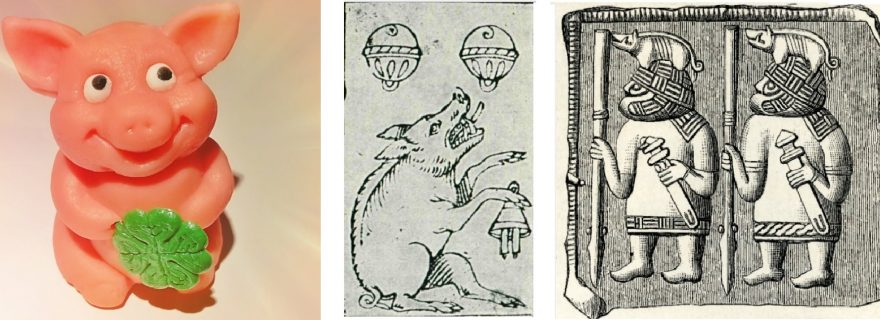Lucky pigs and protective boars: The medieval origins of the Glücksschwein
Why are pigs associated with good luck? Traces of 'lucky pigs' are found in late medieval board and card games, while the use of boar effigies as talismans is attested as far back as the early Middle Ages.
Origins of the Glücksschwein
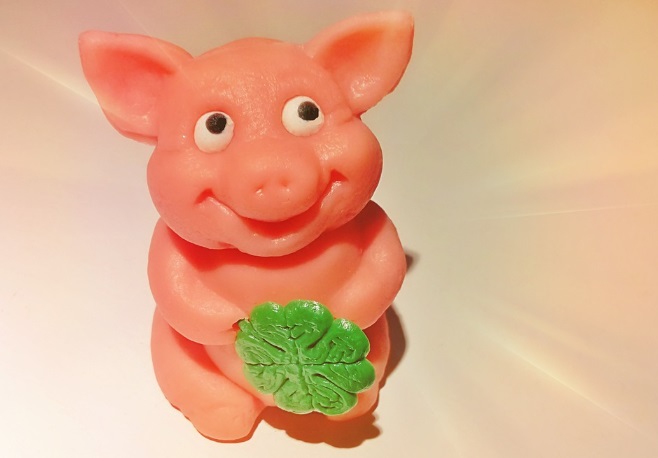
Marzipan Glücksschwein, a popular New Year’s gift in Germany
The German phrase “Schwein haben” [lit. to have a pig] means ‘to be lucky’ and a peculiar New Year’s tradition in Germany is the gifting of marzipan pigs for good luck. The internet abounds with theories about the origins of this peculiar association between pigs and luck, ranging from the idea that pigs were a “sign of wealth and prosperity in the Middle Ages” (source) to a “story [that] dates to the Middle Ages and says the person who came in last in a shooting competition was awarded a pig” (source). While I have not been able to trace these suggested origin stories in actual medieval sources, there is, indeed, evidence that the idea of a lucky pig was already around in the later Middle Ages, when pigs were assigned a high value in board and card games. The use of piggish effigies as talismans has an even longer history.
Pigs at play: The role of the pig in medieval games
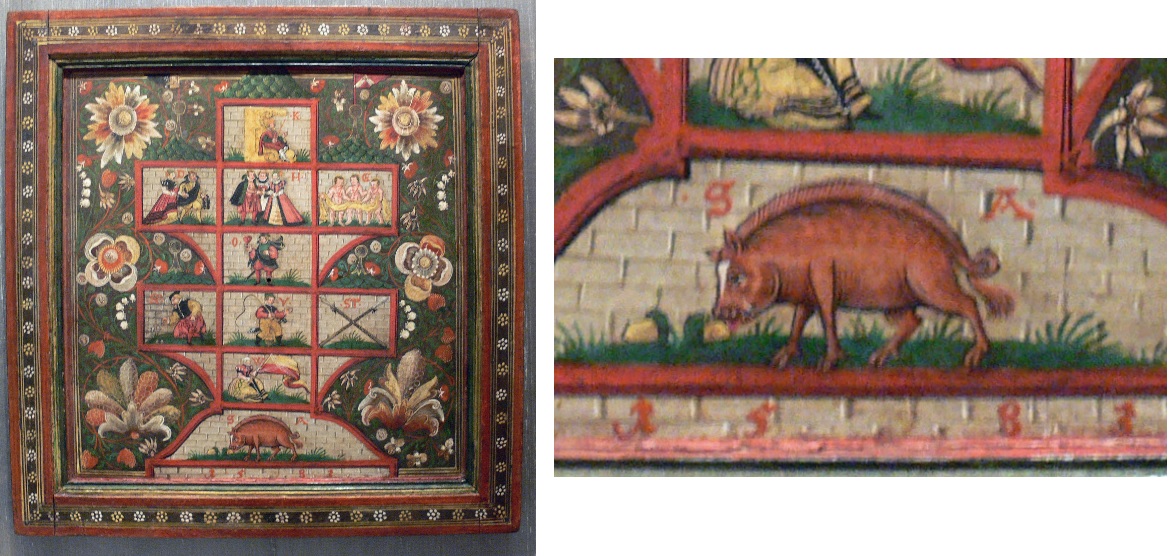
Glückshaus board, 1583. Bayerisches Nationalmuseum, München (source)
The “lucky pig” makes an appearance in the medieval board game Glückshaus [House of Fortune]. This game, probably invented in the fifteenth century but gaining popularity in the Early Modern period, is played with two dices and a board. The board is divided into ten fields, showing all numbers between 2 and 12, excluding 4. The rules of the game, an ancestor of roulette, can vary, but there are a number of consistent features (source for rules):
- If players throw a 3, 5, 6, 8, 9, 10 or 11: they place a coin in the corresponding field on the board or they remove a coin from the board if someone else had already thrown that number.
- If players throw a 7: they always put a coin in the seventh field, creating a jackpot
- If players throw a 4: nothing happens, since that field is not on the board.
- If players throw a 2: the player gets all the coins from the board, except the money in field #7.
- Whoever throws a 12 gets all the coins on the board.
Glückshaus boards, like the sixteenth-century example above, are often beautifully decorated. Field #12, for instance, typically depicts a king, since whoever throws 12 takes all coins on the board. Field #7 usually shows a wedding scene (the jackpot there is usually interpreted as resembling a 'dowry'). Field #2, the best throw aside from 12, always shows a pig: the ‘Lucky pig’. Glückshaus became very popular and soon reached Britain, where it was called ‘House of Fortune’ or, indeed, ‘Lucky Pig’.
Medieval playing cards too assigned a high value to the pig. From the fifteenth century onwards, the 'Dauskarte', the card which is assigned the highest value in the German and Swiss variants of the playing cards, featured a depiction of a swine or a sow (see Rumpf 1976). As such, when you received ‘the sow of hearts’, ‘the sow of acorns’, ‘the sow of bells’ or ‘the sow of leaves’ (the ‘aces’ of the medieval German/Swiss card deck), you were dealt a lucky hand!
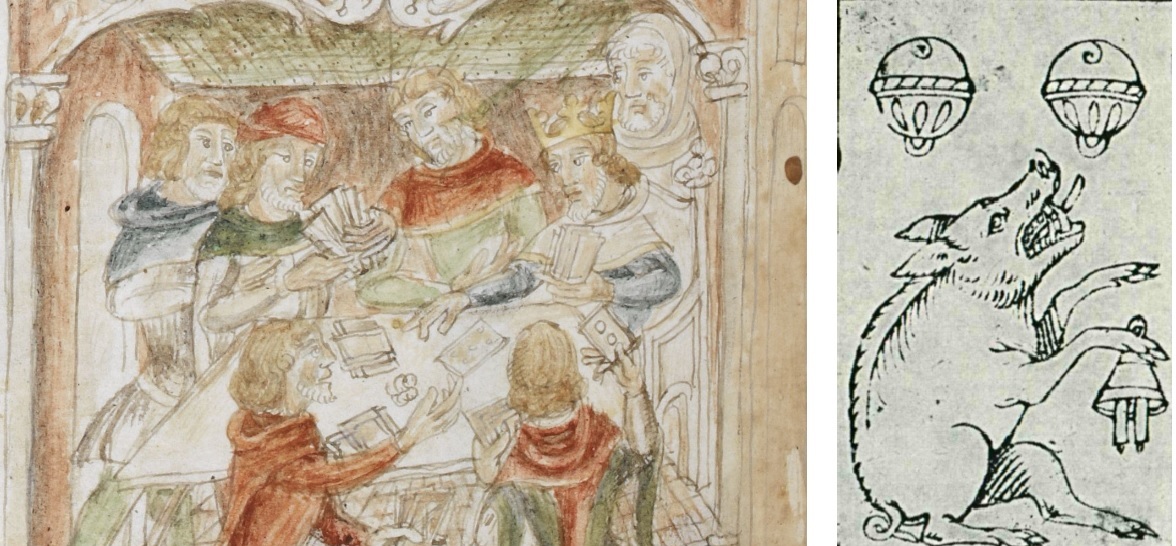
14th-century depiction of a card game (note that the player on the bottom right has a ‘Dauskarte’). British Library, Add MS 12228, fol. 313v (source); Austrian ‘Dauskarte’ features a swine by Hans Forster, 1573 (source)
Boars on a helmet: Apotropaic magic in the early Middle Ages
The association of pigs and good fortune may date even further back: to the early Germanic tribes and their fascination for the wild boar. Some Germanic tribesmen, the Roman historian Tacitus wrote in chapter 45 of his Germania (98 AD), would carry with them “formae aprorum” [images of boars] as a kind of talisman for protection in battle:
They worship the mother of the gods, and wear as a religious symbol the device of a wild boar. This serves as armour, and as a universal defence, rendering the votary of the goddess safe even amidst enemies. (source)
References to this practice also survive in early medieval literature. The Old English poem Elene, for example, makes mention of an eoforcumbol ‘boar-standard’. In the poem Beowulf, too, there is a reference to an eoforheafodsegn ‘lit. boar-head-sign’, usually interpreted as a banner with a boar’s head. In addition, various warriors in Beowulf adorn themselves with “eofor-lic […] fah ond fyr-heard” (ll. 303b-305: A boar image, coloured and fire-hardened), “swyn eal-gylden (l. 1112b: a boar entirely of gold), “eofer iren-heard” (l. 1113a: an iron-hard boar) and “swin ofer helme” (l. 1286a: a swine on top of the helmet). As the last phrase, “swin ofer helme”, suggests, these boar images were typically found on helmets. The hero Beowulf himself also seems to have possessed such a boar helmet, “besette swin-licum, þæt hine syðþan ne / brond ne beadomecas bitan ne meahton” (ll. 1450-1451: Studded with boar images, so that no sword or war-knife could bite him). Like Tacitus, the Beowulf poet here ascribes an ‘apotropaic’ function to the swine images: they are a form of defensive magic.
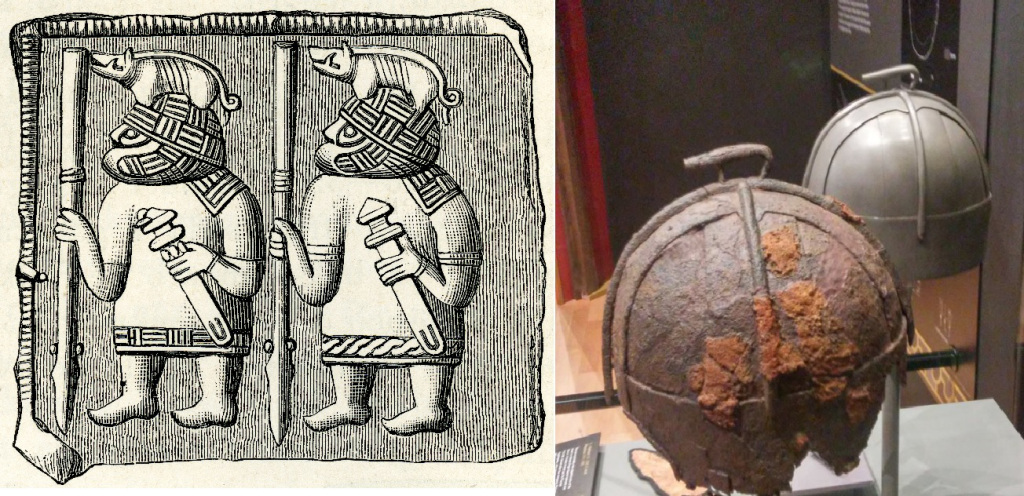
The boar helmet is not a figment of literary imagination. Several archaeological finds from the early Middle Ages confirm the existence of this kind of headgear. One of the seventh-century helmet plates from Torslunda (Sweden), for example, shows two heavily armed warriors, each an effigy of a wild boar on their helmet. These swine are easily recognizable by their tusks, bristles and curly tails. Actual helmets dating from much the same time and complete with boar-crowns have been found in various places in England, such as Benty Grange and Wollaston (see image above). Protected and inspired by the boars on their crests, whoever wore such helmets no doubt considered themselves lucky!
From talismanic boar helmets among early Germanic tribes to lucky marzipan pigs in present-day Germany…it may be a bit of a stretch, but I suppose a medievalist blog that starts on Friday the 13th can use all the good luck charms it can get. May it have a pig!!!
References and suggestions for further reading:
- Heinrich Beck, Das Ebersignum im Germanischen. Ein Beitrag zur germanischen Tier-symbolik (Berlin, 1965)
- Thijs Porck, “Boars of Battle: The Wild Boar in the Early Middle Ages”, Dutch Anglo-Saxonist Blog (27-02-2017)
- Thijs Porck, “Everzwijn”, Madoc: Tijdschrift over de Middeleeuwen 30 (2016), 206-207.
- Marianna Rumpf, “Zur Entwicklung der Spielkartenfarben in der Schweiz, in Deutschland und in Frankreich”, Schweizerisches Archiv für Volkskunde 72 (1976), 1-32
© Thijs Porck and Leiden Medievalists Blog, 2017. Unauthorised use and/or duplication of this material without express and written permission from this site’s author and/or owner is strictly prohibited. Excerpts and links may be used, provided that full and clear credit is given to Thijs Porck and Leiden Medievalists Blog with appropriate and specific direction to the original content.


